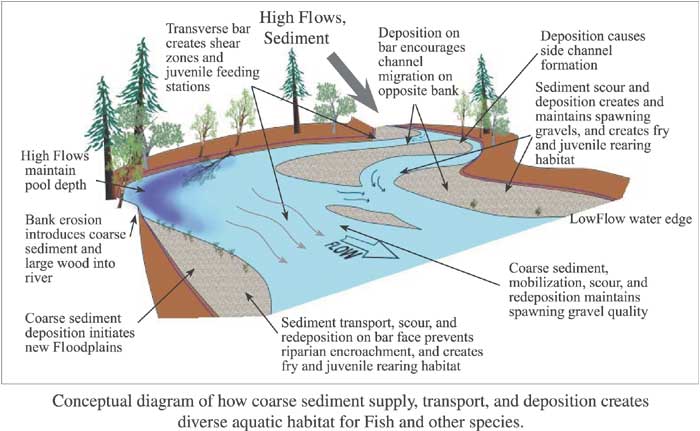 |
| Winter 2008 |
Vol. XVII, No. 1
|
|
TRINITY RIVER RESTORATION PROGRAM
COARSE SEDIMENT MANAGEMENT PLAN, Part 3
The Strategy
The CSMP proposes implementing a strategy of short and long-term coarse sediment introductions. Short term introductions will occur at multiple locations between Lewiston Dam and Indian Creek to quickly replenish coarse sediment storage. Fifty-seven potential short-term coarse sediment introduction sites have been identified in the CSMP, although the actual number of sites implemented will likely be lower. Short-term introduction sites could range from as small as a few hundred cubic yards to over 10,000 cubic yards. Where possible, channel rehabilitation projects upstream of Indian Creek will incorporate coarse sediment introduction into the design. Coarse sediment volume and placement will be unique to each site, based on local hydraulic and geomorphic conditions. The final choice of placement locations, augmentation volume, and method(s) will be determined through a multi-agency design process, responsive to the environmental permitting process and public involvement. Long-term introductions will occur at a small number of locations to maintain coarse sediment storage. Annual replenishments will occur at the long-term sites to approximately match the volume transported by the ROD high flows (currently estimated at approximately 10,000 cubic yards per year).
 |
|
Coarse sediment: is defined as sediment particle sizes 0.08 in. (2 mm) and larger. Proposed coarse sediment introduction sizes range from between 0.3 in. (8 mm) to 6 in. (152 mm), with most between 0.3 in. (8 mm) and 4 in. (102 mm).
|
|
Coarse Sediment Placement Methods
Site specific conditions at each introduction location should dictate which of four methods is best suited and is most appropriate, given the following considerations:
- Topography and high flow hydraulics at each site;
- Maximizing long-term geomorphic benefit;
- Maximizing short- and long-term fish habitat benefits;
- Minimizing construction related impacts on fisheries and landowners;
- Preserving/restoring site aesthetics;
- Placement feasibility and cost effectiveness;
- Analysis of site specific environmental assessment;
- Permitting requirements.
Additional methods may be developed as site conditions and learning dictate.
 |
Illustration of conceptual coarse sediment
placement methods.
|
Performance Monitoring and Adaptive Management
The Trinity River Restoration Program will assess how well individual and cumulative coarse sediment introductions achieve CSMP and ROD goals and objectives. Topographic monitoring will assess how storage changes with high flow releases. Sediment transport measurements during high flow releases will help evaluate how fast coarse sediment moves downstream, which will inform subsequent coarse sediment introductions and high flow releases. Habitat monitoring will assess how coarse sediment introductions, transport, and deposition improve salmon spawning and rearing habitat quality, quantity, and diversity. For more information, contact: Trinity River Restoration Program, 1313 South Main St. Weaverville, CA 96093. Phone: (530) 623-1800
 |
Sediment sampling during high flows measure
the effectiveness of dam releases in routing
gravel and sand through the Trinity River.
(Photo courtesy of Graham Matthews and Associates)
|
|
|
|
This article is the third in a series (see first article and second article) excerpted from Trinity River Restoration Programís brochure, Coarse Sediment Management Plan (CSMP), describing how this project benefits salmonids. |
|
|
Return to the Trinity County RCD Home Page
|







